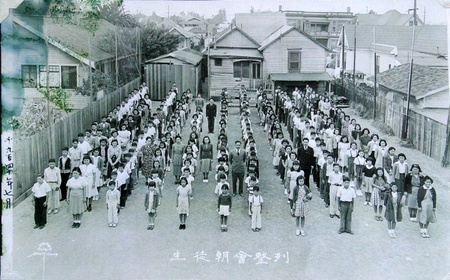No matter where we were, even in a prison camp, schooling took precedence, that is, after food and a place to sleep.
In Los Angeles I had attended Saturday Japanese School. The Nihon gakko consisted of Every-Day-After-School students and Saturday students and naturally the EDAS ones were ahead of us in every way—reading, writing, and calligraphy. We Once-A-Week students were branded “second-rate” and were assigned front row seats, “to better hear Sensei.” Before class began, the student body lined up in perfect rows in the yard behind the building and listened to the exhortations of the principal. One morning he cited the example of a diligent student who had used lunch hour to study rather than take a break to eat. I suddenly realized he was talking about me. In reality I had been frantically pouring over the kanji, the Japanese characters, that were to be on a test after lunch and which I had forgotten to study. I was scrawling them over and over hoping that my hand would click into automatic mode. The principal had walked in, nodded, and muttered, “Um, kanshin, admirable,” and walked out again. I doubt he knew or even cared who I was; he only witnessed a student laboring furiously and assumed I was conscientious. Wouldn’t he have been surprised to learn he had been praising a slacker!

The photograph shows the entire student body, every day students as well as Saturday students, of the Nihon gakko (Nihongo gakko).
Unlike Lockwood Street School, recess here was subdued. The school was located in a shabby ghetto neighborhood and we were admonished to play quietly. “We want no complaints from our friends. We must show them that the Japanese are respectful.” I spent the time drawing pictures, mostly faces with big eyes, and giving them away to my friends. I even audaciously signed my name as if I were a for-real artist. Or, surrounded by these same friends, I told mystery stories, made up on the spot and always to-be-continued the next week. A girl enters a haunted house behind a squeaking door like the one on the radio program, “Inner Sanctum,” and encounters strange visions and noises. Cre.....eeee......ak, I whispered. “The girl slowly opens the door. Cobwebs hang down everywhere and tangle in her hair. She feels something move on her head.” I dramatically jumped off my seat. “ A spider! Hundreds of them.” I nattered on and on, moving the protagonist through countless dark rooms until she reaches the top floor and, of course, finds more closed doors with scary beings and ghosts lurking behind them. The heroine always gets away safely and usually finds a companion girl to accompany her.
I didn’t mind Japanese School, to the disbelief of my friends, especially Helen.
“Well,” she said, “my mother told me that kids like you usually goof around at Japanese school and don’t take it seriously and so you don’t learn a lot.”
I wasn’t sure what “kids like you” meant, so all I managed to protest was, “Oh, yeah?”
I loved my canvas kaban, briefcase, that always smelled Japanese, no matter how old it became.
And I loved the graceful curves of the hiragana letters and tried hard to copy the scrolls and circular symbols with their soft hooks at the ends. We were just beginning brush calligraphy when the war broke out. I was forced to give up my sumi ink block and big brush.
* * *
Now in a desert environment, the Amache school administration offered summer “enrichment” classes, but, of course, not Japanese. I assume the offerings were designed to keep us occupied. I signed up for carpentry but was told it was for boys only. One boy scoffed, “Don’t you know that?” I had visualized the surprise on my father’s face when I told him I knew how to saw a proper cut and how to clamp pieces with Elmer’s Wood Glue to make sturdy joints. We could do our “together thing.” Disappointed, I enrolled in “Nature Study” and “Tonette,” then “Sewing.” The tonette and sewing classes were a cinch. Tonette scores were one-note-at-a-time music. C-C-G-G-A-A-G, Twinkle, Twinkle, Little Star, not the complicated chords of piano music. In sewing I stitched a dirndl skirt and then spent the other weeks helping students with their aprons.
The nature study class was something else. In a cylindrical bottle reeking with an evil smell we imprisoned bugs. The teacher taught us the scientific names of spiders and crickets, and other odd crawly things. Phyla, class, order, family, genus, species. I printed little tags—hexapod, araneida, lepidoptera, byrrhoidea—to display my newfound intelligence, a mysterious lingo in Latin.
I pinned the bugs on a board and neatly pasted the tags below them. My prize, centered on the board, was a furry tarantula—Family: theraphosidae, Order: Araneae.
“Lily, tarantulas don’t live this far north. Are you sure you found it here?” The teacher was dubious.
Where else? Do you think I had slipped away to Arizona, then carried my prize here by Pony Express? Or that I sprouted wings and flew to New Mexico? Are you accusing me of cheating?
“What do you know, anyway,” I blurted. I was immediately sorry when I saw his dumbfounded look. Of course he knew a lot and tarantulas probably weren’t native to Colorado.
At the end of the month I lined up my display with the others for an Open House. However, my father was “outside,” my mother was teaching a class that afternoon, and my brother, probably busy with his friends, didn’t come. Before I returned to my barrack, I detoured to the far end of our block, and without aim, whirled the board over the barbed wire fence as far as I could.
* * *
Author’s note: This is Chapter 3 of Gallery Four of my yet unpublished book, 18286. It is only one of the photographs and watercolors that accompany the story which are not included here.
© 2010 Lily Yuriko Nakai Havey





